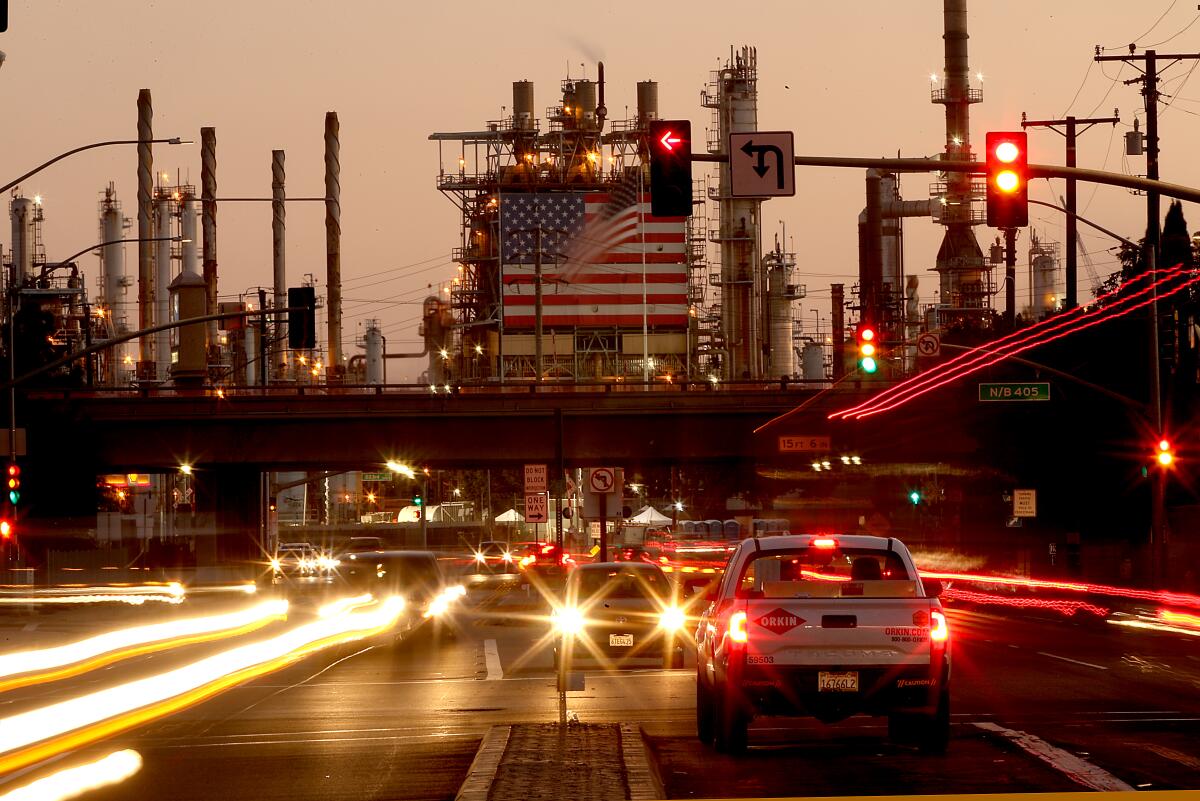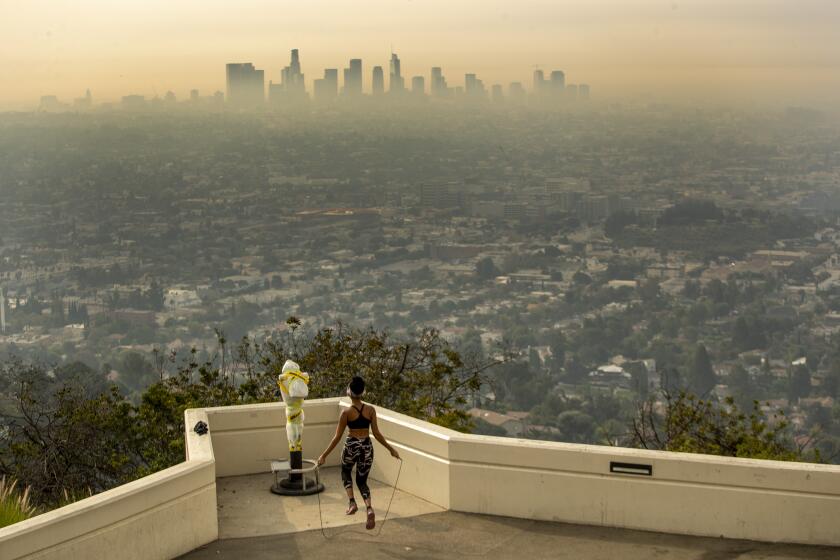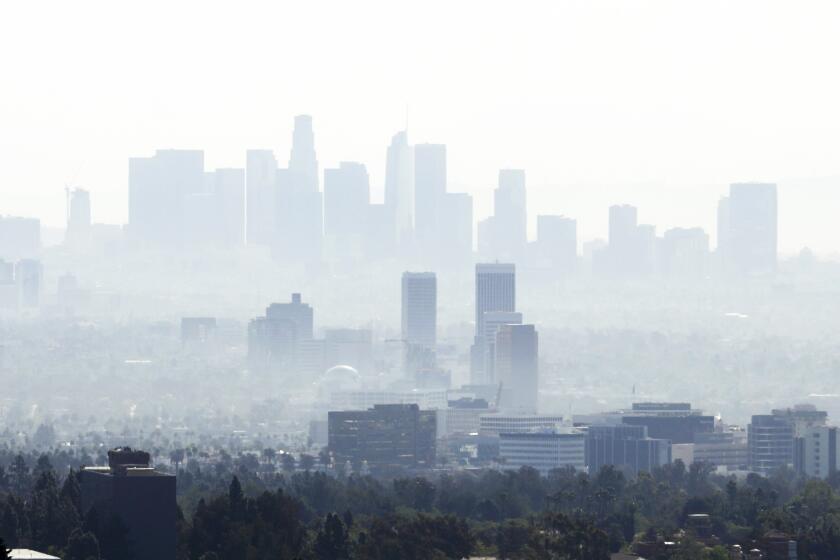SoCal has the worst smog in the nation. So how do major polluters avoid paying fines?

- Share via
A coalition of environmental organizations has accused Southern California air regulators of allowing heavy emitters of smog-forming pollution to avoid hundreds of millions of dollars in federally mandated financial penalties.
Over the past decade, the South Coast Air Quality Management District could have collected more than $200 million in pollution fees from the region’s largest polluters, according to government records obtained by Earthjustice, an environmental law nonprofit headquartered in San Francisco.
Instead, critics say the air district has used a controversial accounting rule it enacted in 2011 to shield polluters from having to pay. The rule allows the agency to forgive the pollution fees if the air district dedicates a dollar-for-dollar match toward emission reduction initiatives. And, more often than not, those matching dollars come from public sources, they say.
In 2021, for example, the air district could have levied about $26 million in pollution fees from facilities. Instead, it excused those payments, citing $113 million worth of clean air projects that the agency funded that year, in part, with motor vehicle registration fees and bond sales, plus a considerable bank of previous credits.
“What they’ve done is they’ve robbed communities of a decade of potential to push these facilities to clean up their pollution,” said Adrian Martinez, an attorney with Earthjustice.
Long-term exposure to fine particulate pollution may increase the risk of developing dementia, new research says.
In a letter to the U.S. Environmental Protection Agency, Earthjustice and four other environmental groups are petitioning the federal government to intervene and require the air district to revise its pollution fee program, arguing this loophole has removed the impetus for these facilities to curb their emissions.
The current system, they say, has primarily benefited oil companies and harmed disadvantaged communities that endure some of the nation’s worst air quality.
Air district officials say critics have mischaracterized their efforts to fight pollution.
According to officials, the rule that petitioners want to reverse actually allows the district to target the region’s largest source of pollution — transport vehicles, such as cars, trucks and trains. Furthermore, the EPA signed off on this approach, which air district officials say is just as stringent as collecting pollution fees.
“Since the majority of our ozone problem is due to mobile sources, South Coast AQMD adopted an alternative program where we calculate what the fee obligation would have been for a source and use the equivalent amount of funding to reduce mobile source pollution,” said Nahal Mogharabi, air district spokesperson.
The South Coast air basin — Los Angeles, Orange, Riverside and part of San Bernadino counties — typically experiences three to four months’ worth of smog in excess of federal standards, and is considered one of the most polluted regions in the nation.
However, the air district has previously argued that facilities within its jurisdiction only account for a fraction of smog-forming emissions. Even if emissions from all large facilities within the region were eliminated, the air basin still wouldn’t meet some federal benchmarks, they say.
Federally regulated sources — cargo ships, freight trains, airplanes and some heavy-duty trucks — are responsible for most of the emissions, air officials say. To that end, the district recently sued the U.S. EPA, claiming the federal agency has made it impossible to meet smog reduction targets, because the EPA has not curbed pollution from ports, railyards and airports.
Under the federal Clean Air Act, regions that fail to meet standards for pollutants such as smog, which is also called ozone, must propose a plan for compliance within a certain time frame. If they fail to meet deadlines, air districts are required to come up with a plan to impose fees on the largest polluters in the region.
The federal government set standards for ozone in 1979, 1997, 2008 and 2015. Forty-four years later, Southern California has yet to meet any of them.
The South Coast air district failed to meet the 1979 standard by the November 2010 deadline. As a result, its fee program required the largest polluters to reduce smog-forming emissions by 20%, or pay a fee for every ton that exceeds benchmarks.
But the air district’s governing board had concerns. The facilities within their jurisdiction already faced the most stringent rules in the nation. Traffic and the movement of goods — not buildings — produced the most pollution. And public entities, such as utilities or universities, might incur fees.
“It is important to note that some stationary sources that would be part of the ... fee program, such as essential public services and medical facilities, could not reduce their throughput to reduce emissions, and thus would be forced to pay a punitive fee,” said Mogharabi, the air district spokesperson.
In 2011, the air district’s governing board adopted the offset rule and the California Air Resources Board and U.S. EPA approved it.
New to L.A. and looking for a place to live, I had to quickly educate myself on the region’s largest polluters, its many microclimates and its topography.
Joe Lyou, a former member of the governing board, was a dissenting vote on the measure.
“It evolved into a smoke-and-mirrors proposal to take credit for incentive funding that should have been applied to reducing ... emissions in the first place,” said Lyou, who now serves as president of the Coalition for Clean Air.
“It made me uncomfortable at the time and still makes me uncomfortable because you can see in the last 10, 12 years we’ve made very little progress toward attaining those standards.”
Earthjustice requested public records to gain a better understanding of the inner workings of the program. They found that oil extraction and refining operations were among the facilities that should have paid the largest penalties — but ultimately didn’t.
In 2021, a Wilmington refinery owned by Marathon Petroleum Corp. was the region’s top polluter and accrued nearly $2.3 million in pollution fees. The facility’s emissions of volatile organic compounds (an assortment of chemicals, like carcinogenic benzene) were twice as high as the baseline levels that the air district wanted reduced by 20%, suggesting its pollution has grown over the years.
Beta Offshore, the company operating the ocean oil platform where 28,000 gallons of crude oil spilled in 2021, racked up $1.5 million in fees. Torrance Refining Co., which has been cited by the air district nearly 50 times since 2016, faced almost $1.2 million in penalties that same year.
Yet none of them, or the other 400 major facilities in the region, were required to pay those fees. Instead, they were offset by what Earthjustice attorneys and other environmental groups called a “grab bag of programs” that use public money to pay for anything from electric landscaping equipment to hydrogen fueling stations. These investments, they say, would’ve been made whether the air district was in compliance with the 1979 standard or not.
Earthjustice attorneys say that oil companies have sidestepped these fees even as they posted record profits in 2022. The largest energy companies — ExxonMobil, Shell, Chevron, BP and TotalEnergies — recorded more than $200 billion in profits.
Marathon Petroleum, the refinery operator, netted $14.5 billion in 2022, compared with $1.6 billion the year before. These profits coincided with sky-high gasoline prices in California, which prompted a law that allows legislators to investigate and impose penalties for price-gouging.
“We’re pretty flexible on discussing [leniency for] essential public services and other things that might have to pay a fee,” said Martinez, the Earthjustice attorney. “But where we aren’t open for discussion is conceding companies that have had record-breaking profits for gouging Californians during the pandemic and have unapologetically been denying climate change for decades — that they shouldn’t have to pay this fee. We’re sick and tired of giving refineries a free pass.”
A spokesperson for the Western States Petroleum Assn. declined to comment on the air district’s fee program.
Beyond the uncollected fees from the 1979 ozone standard, the air district now appears poised to miss its deadline to comply with the 1997 ozone standard next year. Under the Clean Air Act, the air district should have drafted a separate slate of pollution fees.
Environmental activists, including actor Daryl Hannah, have seized on Barbie’s popularity to spark a broader conversation about plastic pollution.
“It’s kind of crazy to think we have regions that fail to meet multiple standards at one time,” Martinez said. “But for better or worse, we are that region.”
Although South Coast was required to design that new set of fees by June 2014, it has yet to do so. Earthjustice and the other organizations have also filed a lawsuit in federal court against the air district and the California Air Resources Board for failing to draft a new fee program, which they argue is required by the Clean Air Act and not discretionary.
The air district and CARB declined to comment on the litigation.
The air district, however, is scheduled to discuss pollution fees in the second quarter of 2024, according to its rulemaking calendar.
The conversation will likely center on the economic impacts to Southern California businesses. But many, like Lyou, believe the fees are minuscule in comparison to the health benefits of reducing pollution: the premature deaths, hospital admissions and missed days of school and work.
“It’s going to be expensive, it’s going to be painful,” he said. “But, again, it’s still going to be saving us money on the whole because the health impacts are so incredibly costly. We just don’t see it.”










